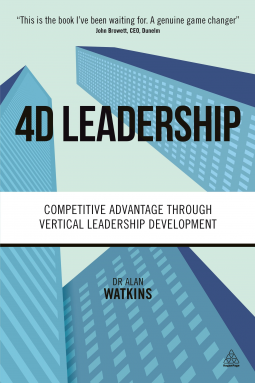
4D Leadership
Competitive Advantage Through Vertical Leadership Development
by Alan Watkins
This title was previously available on NetGalley and is now archived.
Send NetGalley books directly to your Kindle or Kindle app
1
To read on a Kindle or Kindle app, please add kindle@netgalley.com as an approved email address to receive files in your Amazon account. Click here for step-by-step instructions.
2
Also find your Kindle email address within your Amazon account, and enter it here.
Pub Date Dec 28 2015 | Archive Date Feb 11 2016
Kogan Page USA | Kogan Page
Description
Advance Praise
--John Browett, CEO, Dunelm
This is the book I've been waiting for. A genuine game changer."
--John Browett, CEO, Dunelm
Available Editions
| EDITION | Paperback |
| ISBN | 9780749474645 |
| PRICE | $29.95 (USD) |
Average rating from 6 members
Featured Reviews
 John G, Reviewer
John G, Reviewer
Despite the complexity and ambiguity of the world today, we all have the potential to develop as leaders, according to Alan Watkins in his book 4D Leadership: Competitive Advantage Through Vertical Leadership Development. Successful leadership development requires a focus on upgrading our operating system, not just adding-on more ‘apps’ in the form of skills and experience.
Most leaders are fairly competent at the “IT” dimension of leadership (tasks and getting things done), but less competent at the “I” dimension (self-mastery and understanding and controlling one’s own emotions) and the “WE” dimension (relating and communicating with other people). The fourth, or vertical, dimension, involves development in each of the other three dimensions and, according to the author, requires far more than just learning.
The book discusses a number of ways of assessing and developing skill levels in each of the IT, I and WE dimensions. Although I have read a lot of leadership books, most of the frameworks advocated by the author are new to me. Many of them seem very helpful, but I started having some doubts half way through the Leadership Maturity Profile. Apparently only 15% of individuals make the “quantum leap” to the level of Human Being 4.0, the Pluralist, who understands that “truth is culturally conditioned and nothing is ever totally objective”. Even fewer people make it to the more esoteric and mystical levels such as Human Being 5.0, the Alchemist, and Human Being 6.0, Embodied. Those of us who dwell on the lower levels are unable to understand more than two levels above our station, so my scepticism is apparently attributable to my ignorance.
In my opinion the book does contain a wealth of interesting ideas and information, which readers are unlikely to have encountered in other books on leadership.
This book provides a number of interesting and potentially useful frameworks and ideas for leadership development.
Readers who liked this book also liked:
John Kotter; Holger Rathgeber
Business, Leadership, Finance, Nonfiction (Adult)













